But the breathing may not be so easy…
Chiang Mai has been on our must visit list since we started this crazy lifestyle. Located in northern Thailand at 310 meters elevation, this city’s climate in winter is a little cooler than the coastal areas of Thailand. It’s also become a major digital nomad hub in the last few years. One of the common pieces of advice is to only book a few days in a hotel or Airbnb ahead of time and wander around and you will find lots of apartments to rent.

Planning Our Visit to Chiang Mai
We now had our marching orders: plan on spending a least a month, but reserve ahead of time only a few days to a week. That plan fit in perfectly with our procrastination, combined with the cruise, combined with our FOMO (fear of missing out). That is, what if we really fell in love with one of the ports we visited on the cruise and wanted to return and spend the whole winter in our perfect destination, blissed out, sitting in a yoga pose and singing kumbaya all day? Yes, that is what we were really thinking, well except maybe the yoga and kumbaya part.
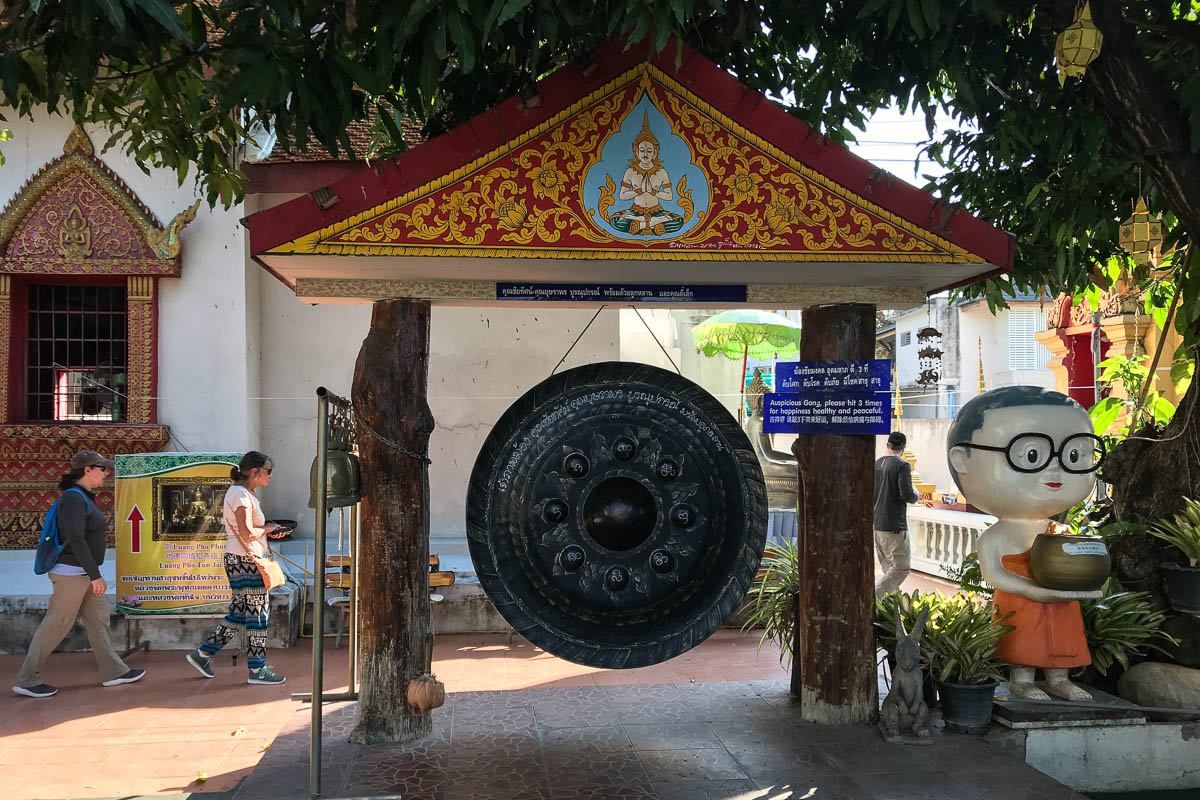
But…being the practical people we are, who were in can’t make a decision mode, but who have been around this dance floor a few times in our two and a half years of travelling…Two days before we were leaving on the cruise from Singapore, we decided to book a week in a Chiang Mai with one-way airfare from Singapore at the end of the cruise.
Heading to Chiang Mai
We selected an Airbnb in the heart of the popular expat and digital nomad neighborhood of Nimmanhaemin (Nimman) for $49 a night, $343 for the week. We knew we were paying a premium because we were booking last minute (the less expensive places were gone), we were in the heart of Nimman, we were booking on Airbnb, we were only booking for a week, and we were coming at the peak time (early January). Just to give you an idea of how we could have saved money, our friends, Amanda and Seth of Elder Millennial Digital Nomads (also on Facebook), who booked ahead and were staying in a less popular neighborhood, were paying $500 for a whole month. But hey, it’s the champagne and caviar lifestyle for us.

Will We Have a Problem at the Airport?
Normally we have our transportation out of a country arranged before we arrive. A few times when travelling on one-way tickets, when checking in for a flight we’ve been asked to show proof that we had transportation out of the country. Luckily, the AirAsia check-in agent didn’t ask and neither did the Thai immigration official. Since we were coming in after dark, we opted to take our Airbnb host up on her offer to arrange for a driver to meet us and take us to the apartment for 300 Thai baht ($10). A little foreshadowing about how inexpensive Chiang Mai was going to be.
Can You Really Find Cheap Apartments by Walking Around?
Following all the advice we’d read, we wandered around Nimman over the next few days looking for apartments to rent by the month. We didn’t see a single apartment, we saw only a few rooms for rent. So, we guessed that the advice only works if you arrive in November or early December ahead of most of the digital nomads. At this point, we decided to stay one more week in Chiang Mai and booked a new Airbnb for $38 a night in the neighborhood around Chiang Mai University, since our Airbnb was booked for the following week.
Our Apartments in Chiang Mai
As stated earlier, we booked an Airbnb apartment in the Nimman area. Although a bit small, the apartment was modern and comfortable in a well-maintained secure building with a pool and gym. (We used the gym, not the pool.) The building was on a quiet side street about two blocks off the main road, about a 10-minute walk to the Maya Plaza Lifestyle Center.
This modern 5-level mall has a tremendous amount of food options, mostly on the top and bottom levels, with a full-sized grocery store on the bottom level. But our favorite was the food stalls in the center of the top floor. Picture six large rectangular areas with food prep on the inside and a bunch of small, very low (Ian said he felt like he was in kindergarten) plastic stools around the outer edges. Within each rectangle were six or eight different food vendors. We were here almost daily! Very delicious and very cheap! Our only regret was that we didn’t get to try them all.
The Second Apartment
Our second apartment was in the neighborhood of Chiang Mai University. Again, the apartment was in a modern, well-maintained building with a gym and pool. (And again, used the gym, not the pool, which looked quite nice.) Although a bit smaller than the first apartment, it had good use of space, felt larger, and was comfortable. We could see the nearby green mountains, that is, on the rare day that the air quality was good, but we preferred the vibe and food options in Nimman.
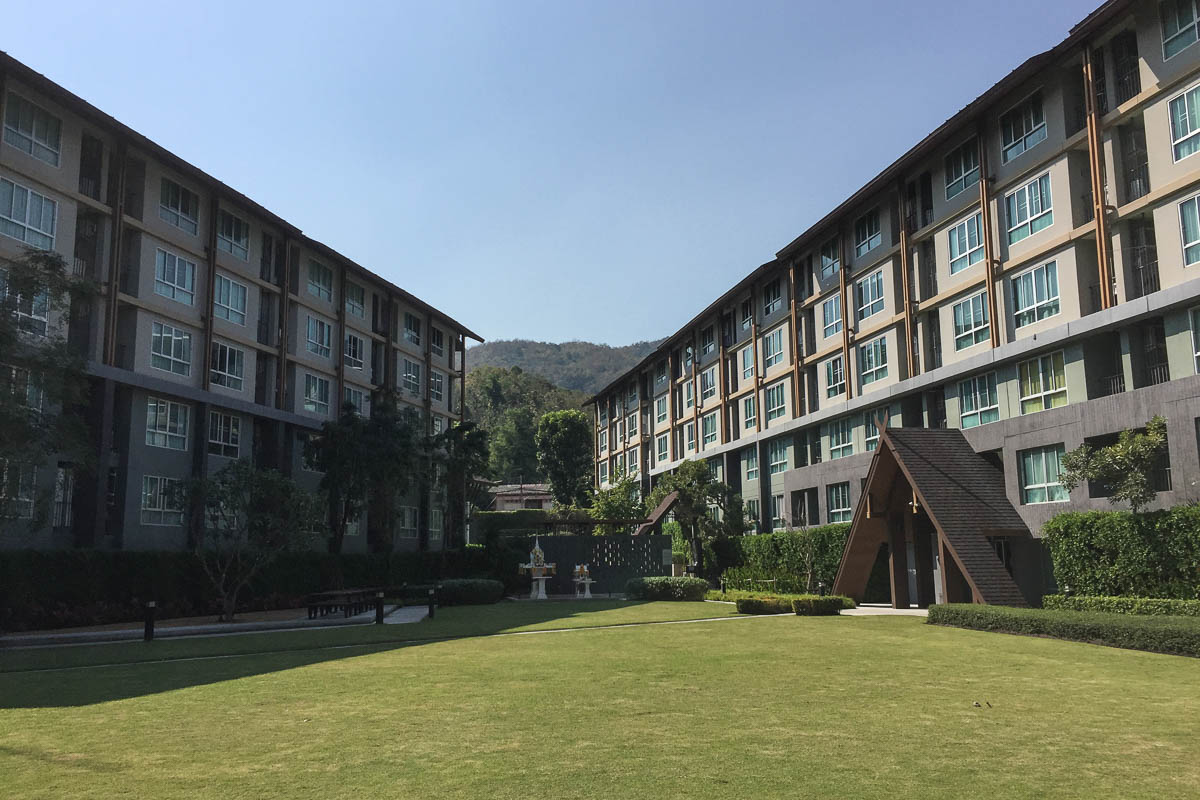
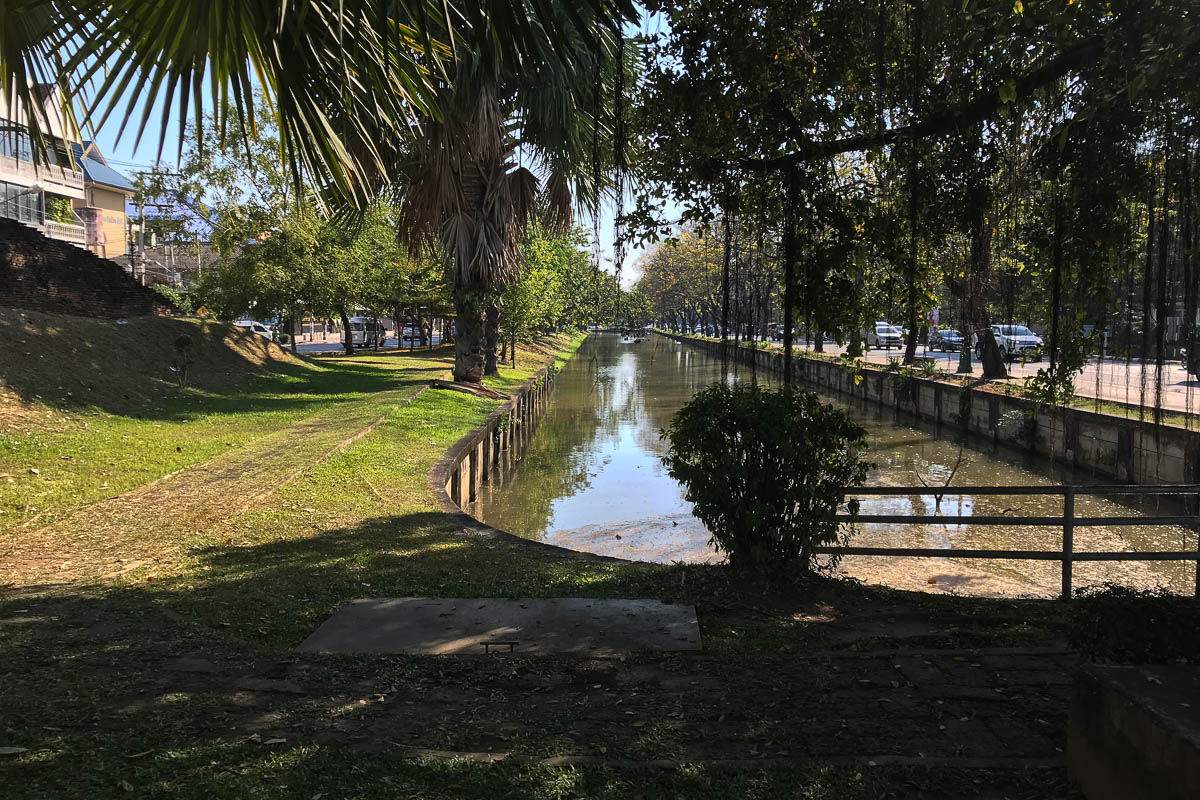
Chiang Mai Old City

Much of our time in Chiang Mai was spent with Amanda and Seth. From Washington state, we actually met them last winter in Medellin on an organized hike through Barrio Moravia with Kinkaju Hikes and Adventures. We also spent an afternoon with them last summer when we both managed to be in Bucharest on the same day! We have now met up with them on three continents!

One of our outings included exploring Chiang Mai’s Old City, inside the old walls, stopping in at various temples along the way.

It seems one can’t go more than a block without seeing another temple. All our outings involved food.
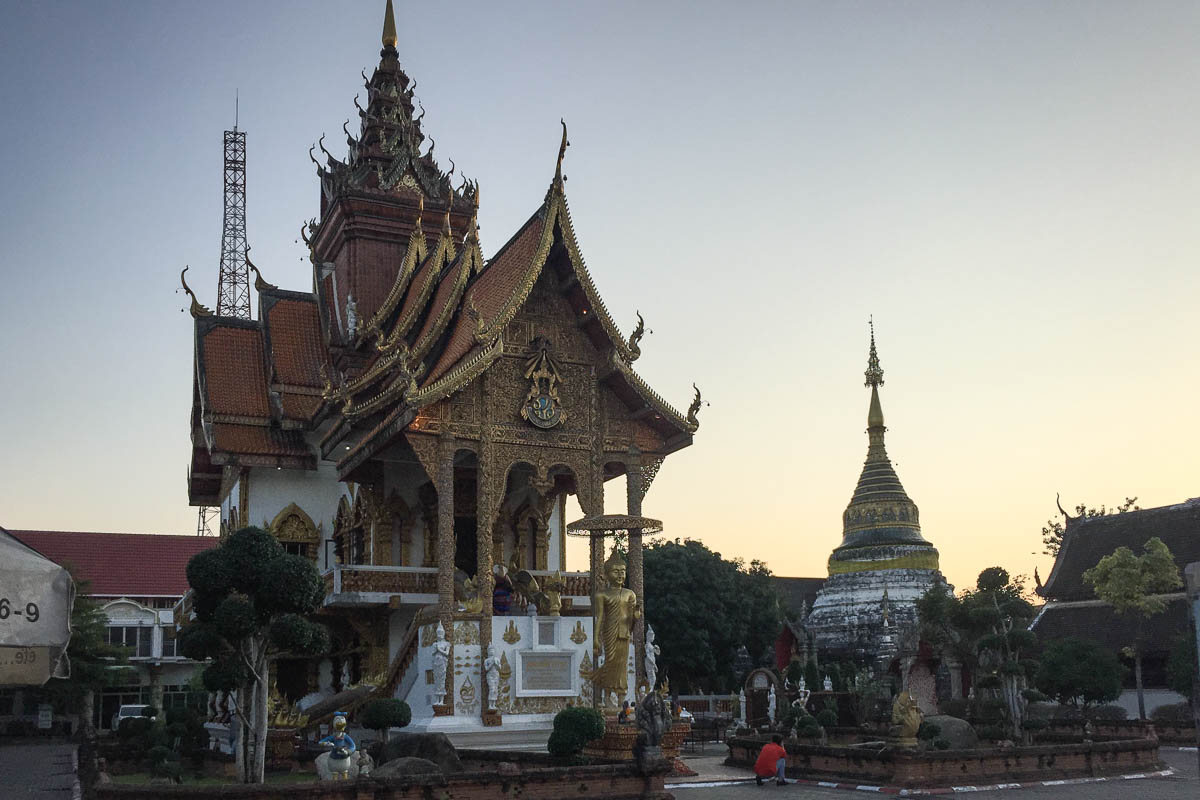
On this day, we had dinner at the Ploen Ruedee Night Market. It was here that we first tried one of our new favorite dishes, Khao Soi. Khao Soi is a northern Thailand dish, and many refer to it at the dish of Chiang Mai. It is made with red curry paste, turmeric and curry powder. In Chiang Mai, it is served with shallots, pickled cabbage, roasted chiles (makes it quite spicy!), and a lime wedge, usually with a choice of beef, pork, or chicken leg, with egg noodles in a broth.
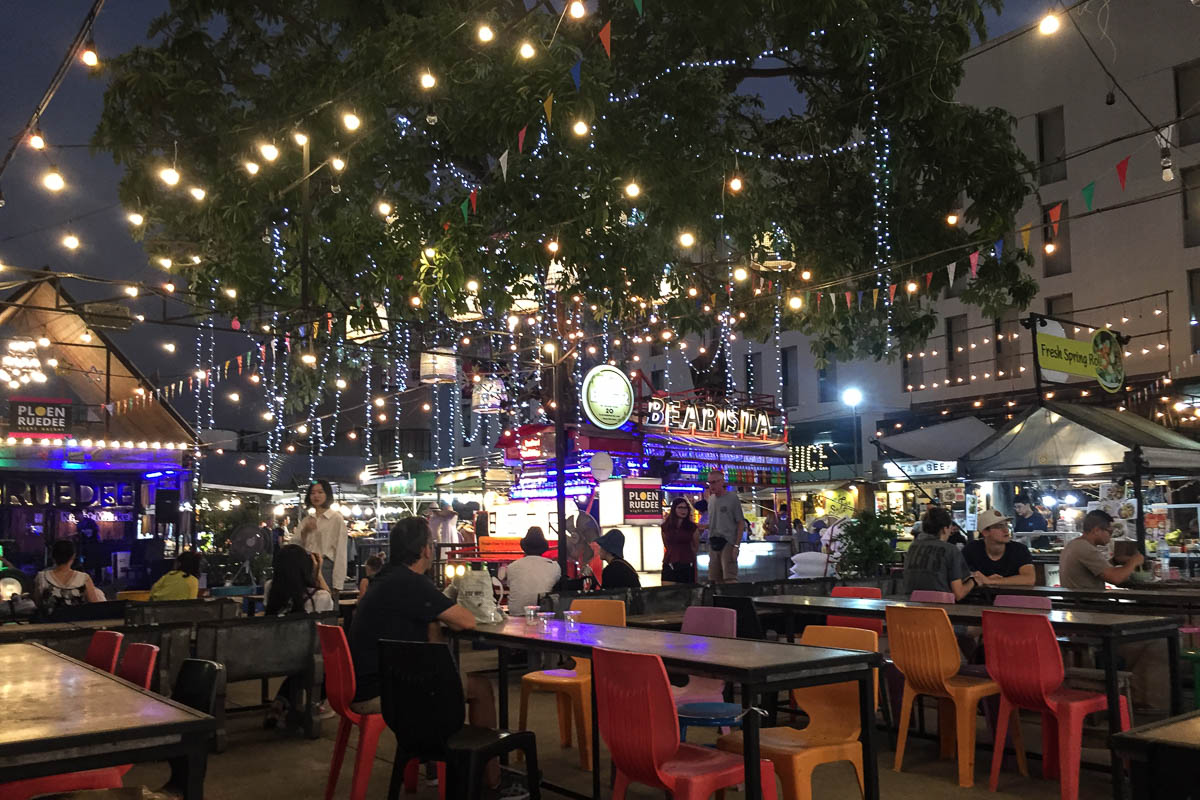
Chiang Mai Sunday Night Market
In a word: crowded! This massive market runs for several blocks in the Old City, offering merchandise of all sorts, musical entertainment, massages, and of course, delicious and cheap food.

We spent a few hours just wandering, grabbing something to eat or drink here and there. What we chose: Pad Thai, chicken on a stick, steamed pork buns, a fruit smoothie, Thai iced tea, and tarts, all for 270 Thai baht ($8.75). We wrapped up the evening with head, neck, shoulder, back, and foot massages for just 150 baht ($4.80) for 60 minutes! We got to sit in comfortable chairs for foot part, but sat on little, low to the ground, plastic chairs for the rest. But who’s complaining?
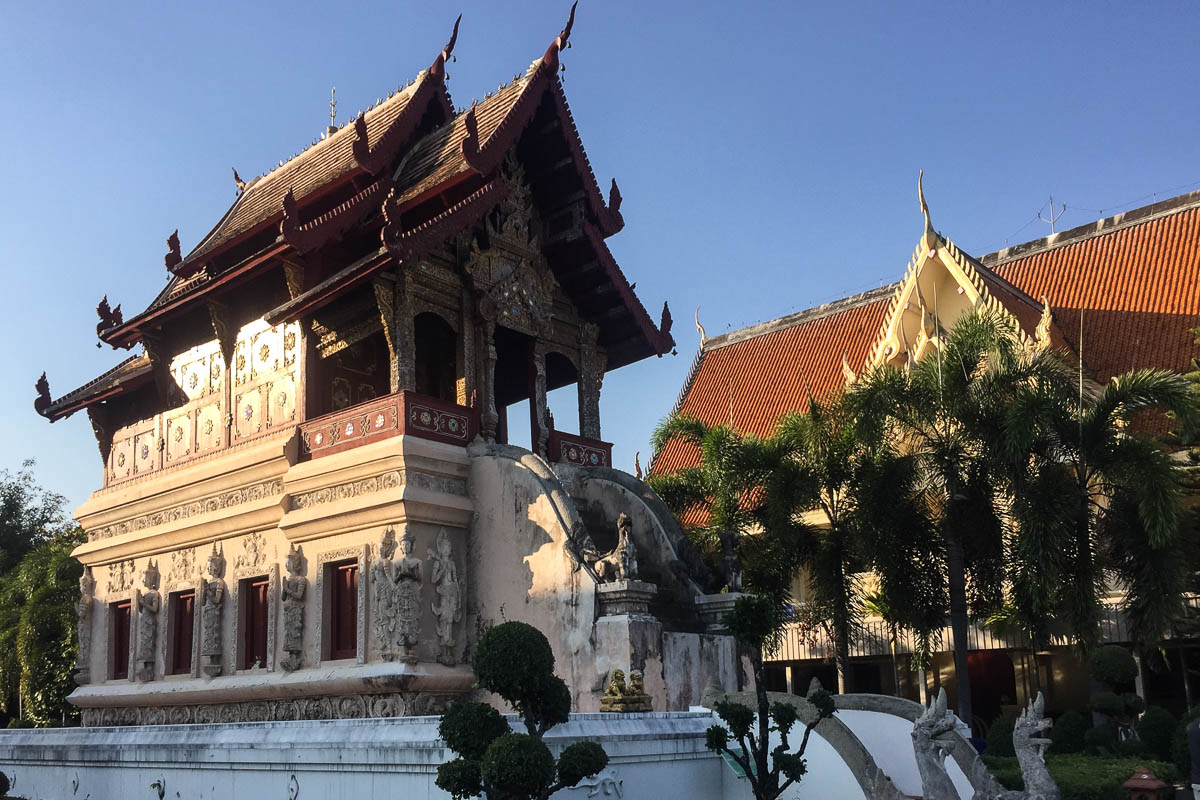
Our Primary Pastime in Chiang Mai – Thai Food
As mentioned earlier, the top floor of the Maya Plaza mall near our apartment in Nimman offered a huge variety of inexpensive food. You’d find us there just about every day for lunch, the biggest conundrum being which dishes to try. From various noodle or rice dishes to boat noodle soup to Khao Soi. And every day, a Thai iced tea with boba and a mango smoothie! We had first become addicted to mango smoothies in Ao Nang. Our daily lunches cost on average 200 baht ($6.60).
At a Different Mall
Amanda’s and Seth’s apartment was near an even larger mall, Central Festival. An interesting feature was that all stores on any given level offered the same category of products. The top level of this mall, besides the food court, also had an amusement arcade and in indoor ice rink. The food court here was a bit more upscale looking than the one in Maya, with actual tables and chairs (not stools) though the prices were about the same. You would get what looks like a credit card at a central location, load it with whatever amount of money you chose, and use it to purchase your food. This way, the food vendors never had to handle cash. In the end, you could return the card and get back any unused portion of money. We met Amanda and Seth here a couple of times.
At both malls, a young, uniformed guard saluted patrons as they entered.
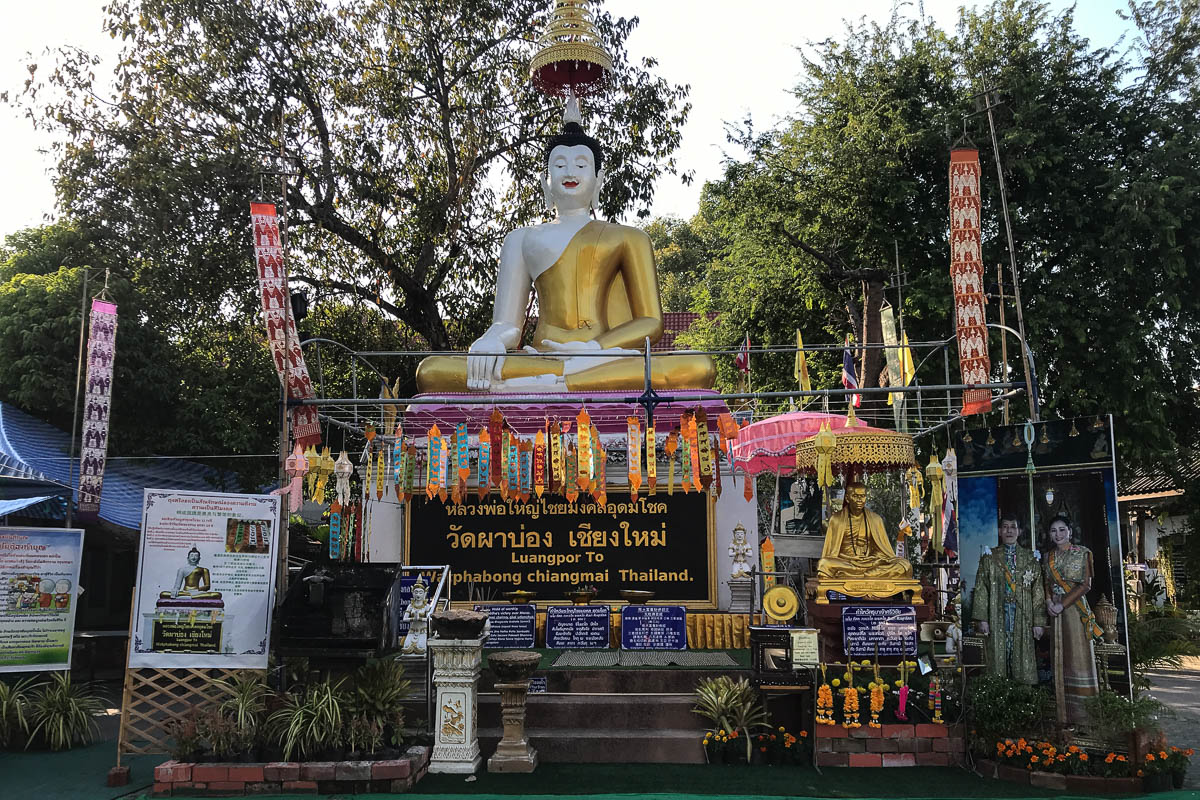
Different Neighborhood, Different Food Situation
Unfortunately, no mall in our university neighborhood, and Ian didn’t feel comfortable with the cleanliness of the street vendors at the local night market.

After a couple of days though, we did find a few favorite restaurants. And one exception to the street vendors! Every night, we saw long lines of mostly students, at the cart of this one lone street vendor in front of one of the 7 Elevens. Ann was determined to try it! A woman sold only one item, Thai Basil, small or large, 25 of 30 baht ($ .80, .96), with chicken or pork, served with rice. We already knew we liked Thai Basil, and the default is usually quite spicy. The woman asked if we wanted spicy, we said a little, then a little more, which became more than little more. Whoa! Lips and mouths on fire, eyes tearing, runny noses…but it was delicious!
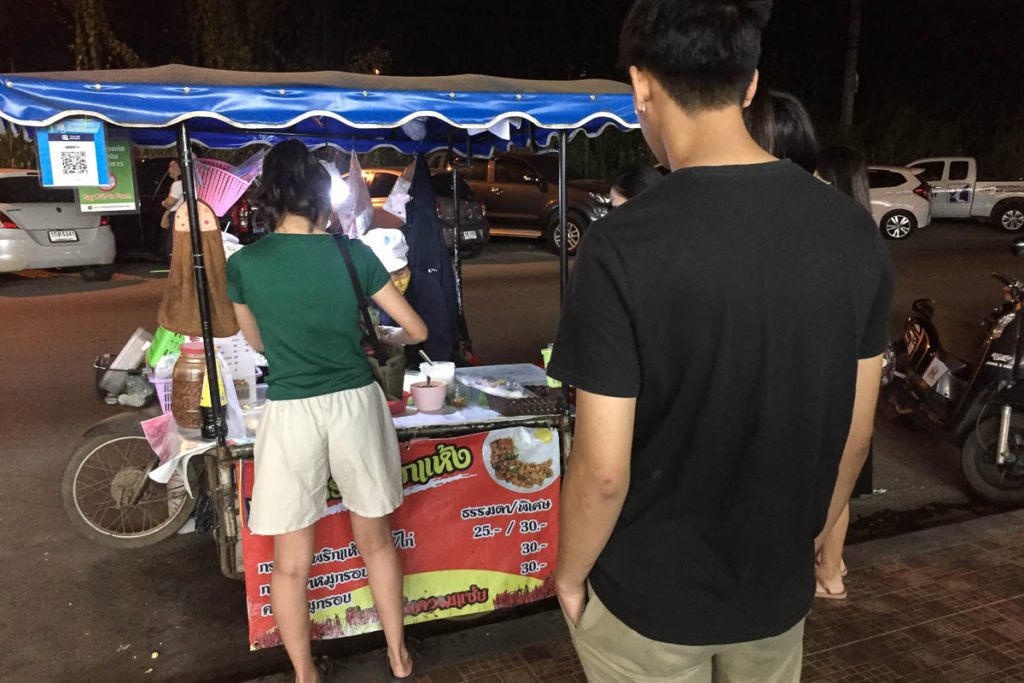
As we continued our travels throughout Southeast Asia, we would find (we think) as Westerners, we would almost always be asked if we wanted spicy. And of course, we would always say, Yes!
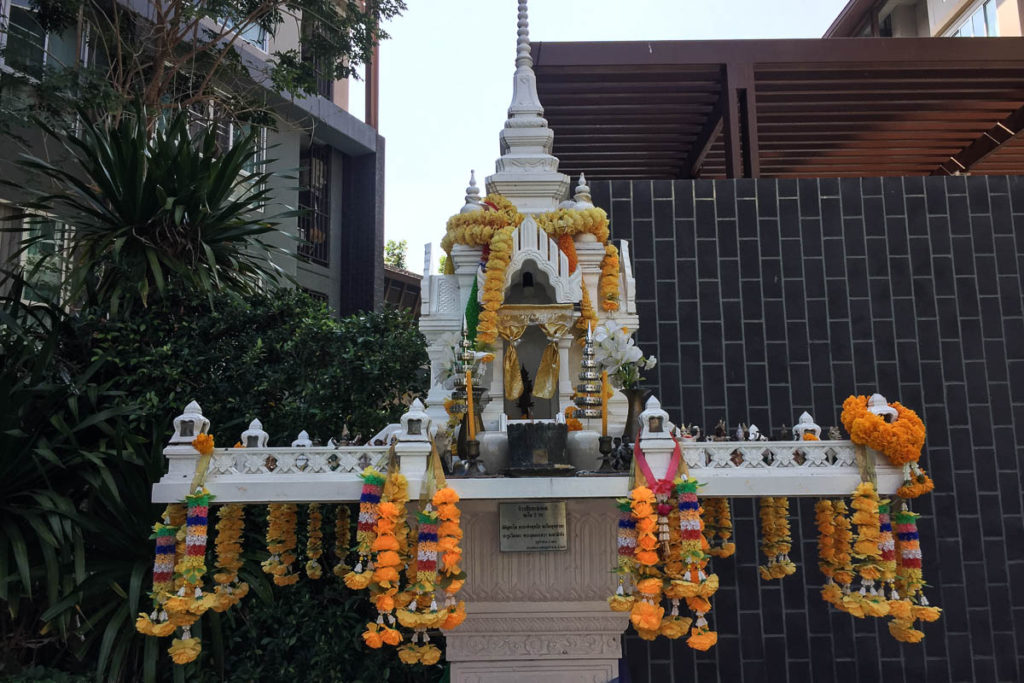
Thai Cooking Class
One of the highlights (at least for Ann, who, unlike Ian, hadn’t done an Asian cooking class before) of our time in Chiang Mai was our cooking class with the Baan Farm Thai Cooking School. Once again with Amanda and Seth.
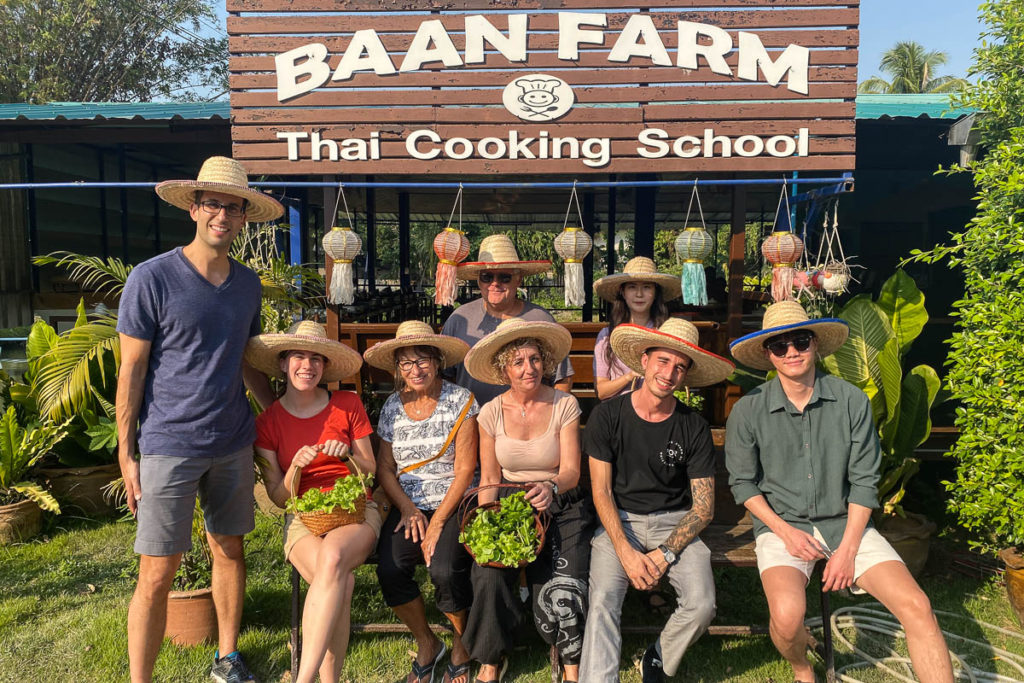
We were picked up at our apartment by a Songthaew (see Wrap-Up below). First stop was the local market to learn about the key ingredients. Then out to the farm/cooking school where we picked from the garden the necessary herbs for the five dishes each that we would cook. Thai cooking is largely about the spices. We got to make Thai curry paste from scratch, using no fewer than a dozen different ingredients, and taking turns at the hard work of grinding using a mortar and pestle.
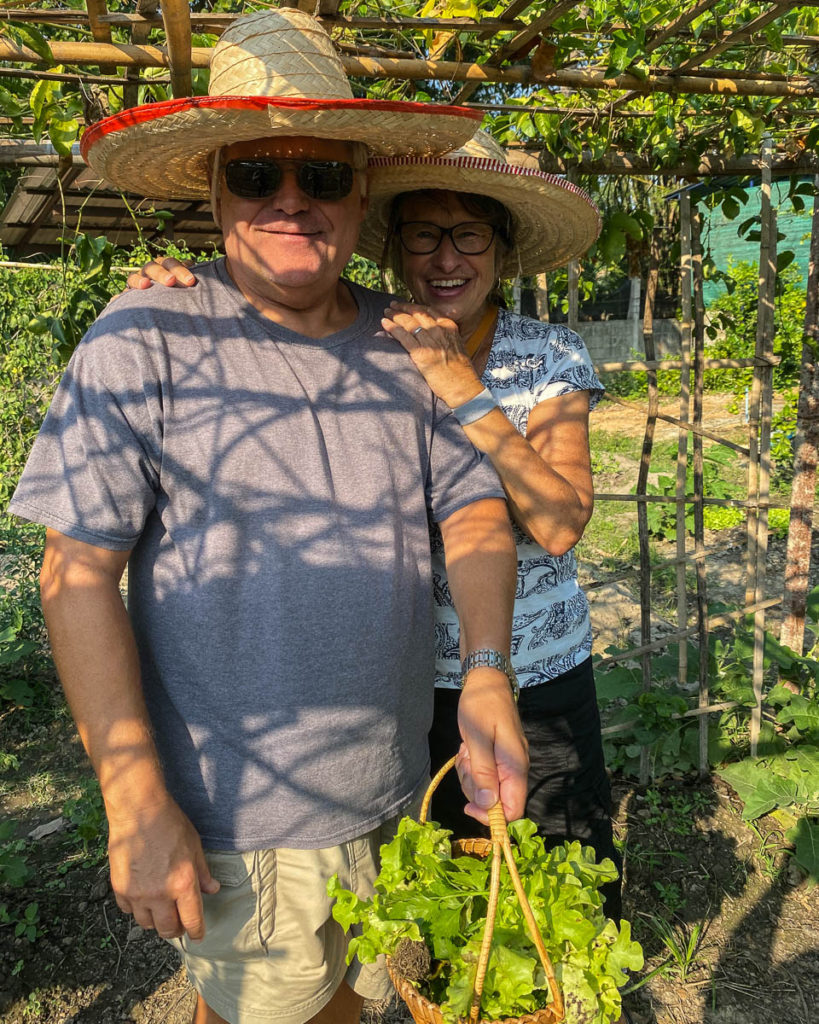
Budding Chefs
The class, with a maximum of 15 participants, was well organized with several assistants. We each got to cook five different dishes, one each from a selection of appetizers, soups, curries, stir-fries, and desserts. Amazing how many delicious dishes we cooked in a short period of time! Of course, the staff had prepped all the ingredients for us ahead of time.
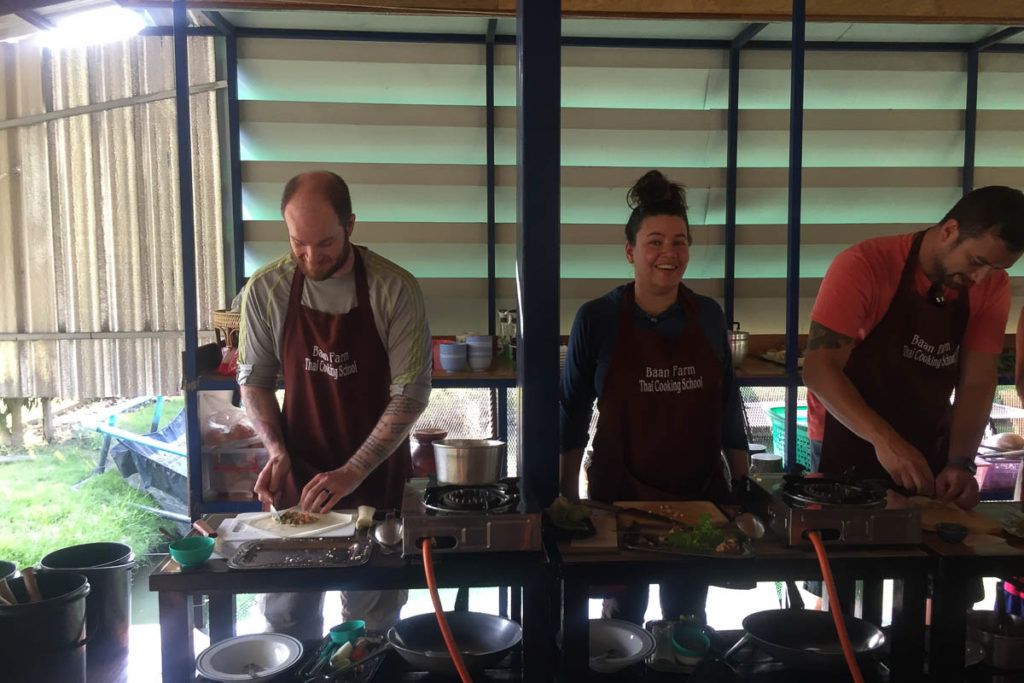
Our Choice of Thai Dishes
We chose different dishes; the more we made, the more we could sample.
Ian’s menu: larb (spicy chicken salad), Tom Kha Kai (spicy sour soup with chicken and coconut cream), Panang curry, Pad Thai (stir-fried small rice noodles with shrimp), and banana in coconut milk.
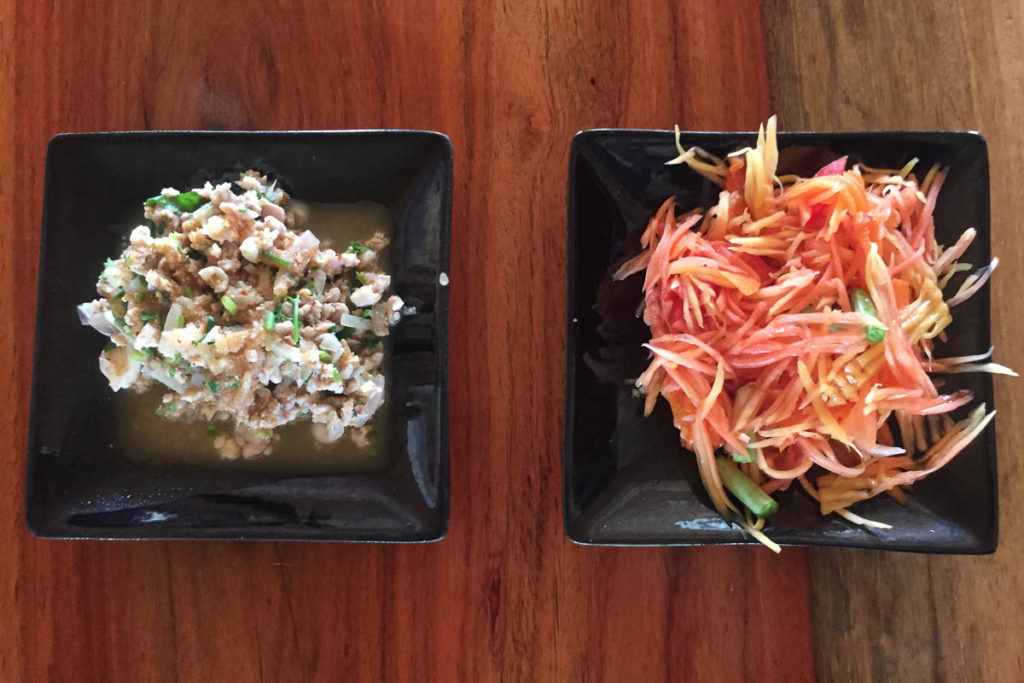
Ann’s menu: Som Tam (papaya salad), Kuai Tiao (Thai noodle soup), Khao Soi (Chiang Mai noodle soup), stir-fried morning glory (an herb plant that tastes like basil with a twist of mint, this dish has a lot of garlic), and mango sticky rice. We had heard and read about this dessert and this was the first time we tried it – yum!
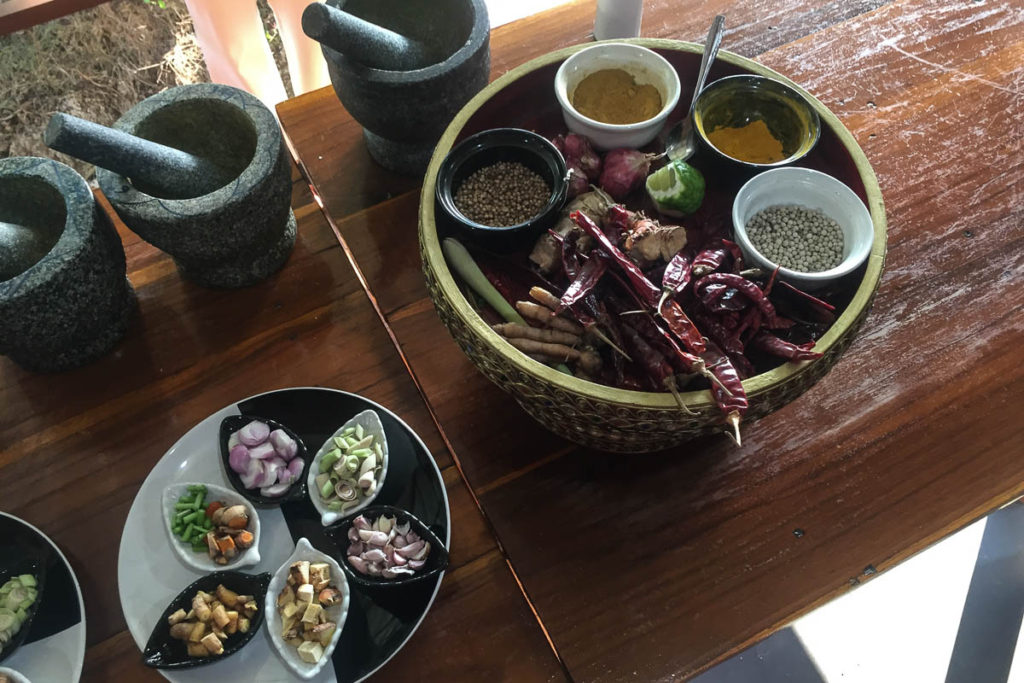
Thanks to the prep work and guidance of staff, turns out we are experts at Thai cooking. All dishes were super yummy! After five hours, we were driven back to our apartment. The entire experience cost just US$32 each!
Chiang Mai Wrap-Up
By the end of our two weeks in Chiang Mai, we felt rather proficient about meeting the challenge of crossing the street. Despite a gazillion motorcycles and scooters and very few traffic lights.

For longer distances, buses, red shared taxis (trucks called Songthaews) which seat eight, and Grab (like Uber) are inexpensive. Ann was a bit tickled by the shoes everywhere outside the doors of businesses, especially massage places.

Did We Make the Right Decision?
In the end, we are glad that we hadn’t booked a month because the burning (of crops) season started early this year, and the air quality became unhealthy. We’d been warned about the burning season which usually starts some time in February and lasts through mid-April. During our stay, we learned that the season has been tending toward an earlier start. We arrived in early January and used an app called AirVisual to monitor the air quality. Highly recommended app if travelling to inland towns or cities in Asia or elsewhere around the world. During our two weeks stay, we had unhealthy days about half of the time. We are going to continue monitoring over the next few months to see how bad it gets during the remainder of the burning season.

Does Chiang Mai Make the Cut?
Would we return? Not sure. We enjoyed our time here, and especially the yummy, very inexpensive food. If we do return, we would stay in the Nimman area and perhaps come earlier in the winter, November or December, to avoid the unhealthy air during burning season and to get less expensive apartments in Nimman.
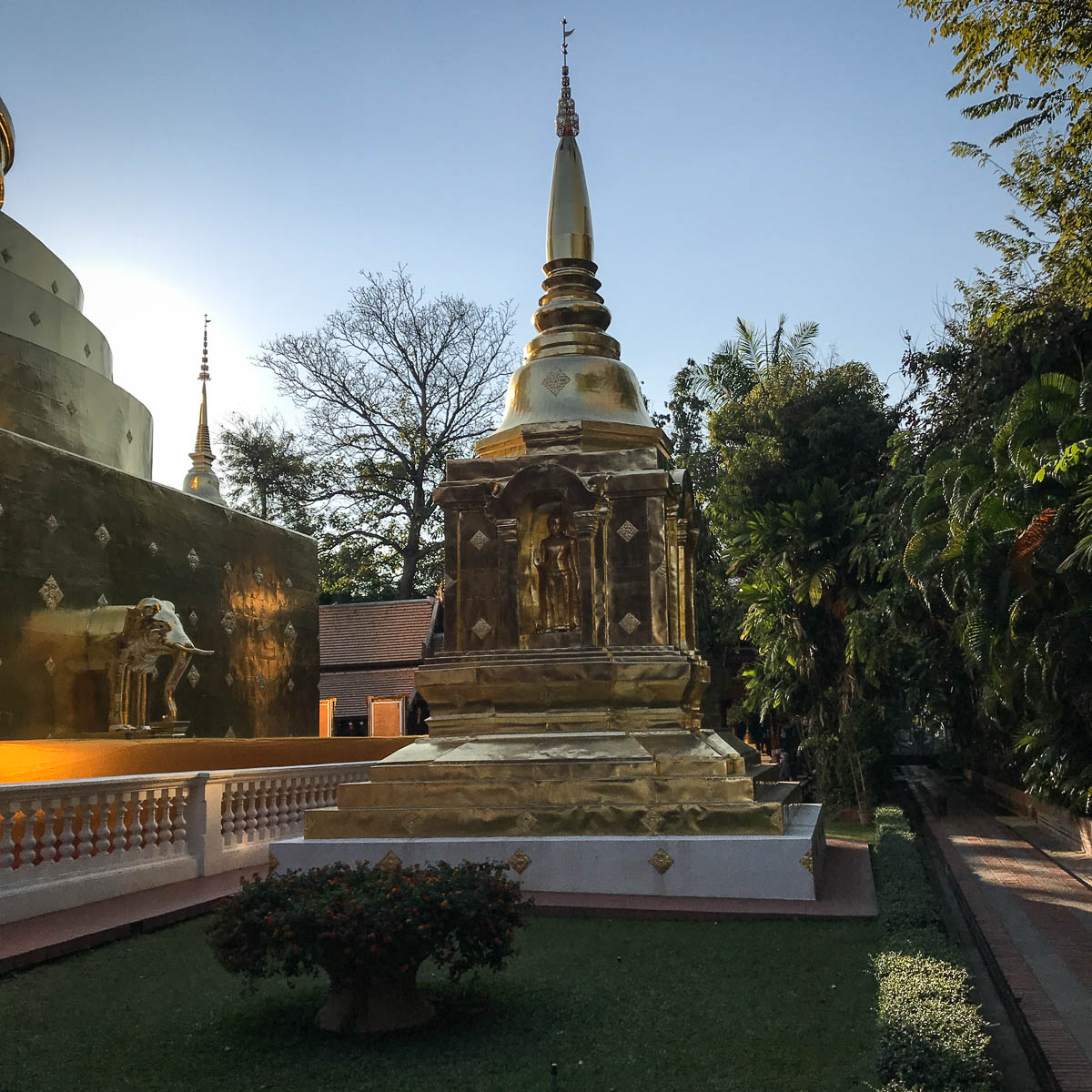
Next Up: Kata Beach, Phuket, Thailand
Ian and Ann

2 Comments
Great travel log of Chaing Mai. One of your photos of a ‘shrine’ looked like a spirit house. When they build on a piece of land, the spirit of that land is displaced. Therefore, they build a spirit house on the land for the spirit to reside. And yes, people will bring offerings to the spirit house. We had a spirit house in our compound. The maids would give offerings of cooked chicken etc. I never found out if they go back and collect chicken and eat it or if they throw it away.
Hi Karen,
How interesting! Thanks for the enlightenment!
Ian and Ann